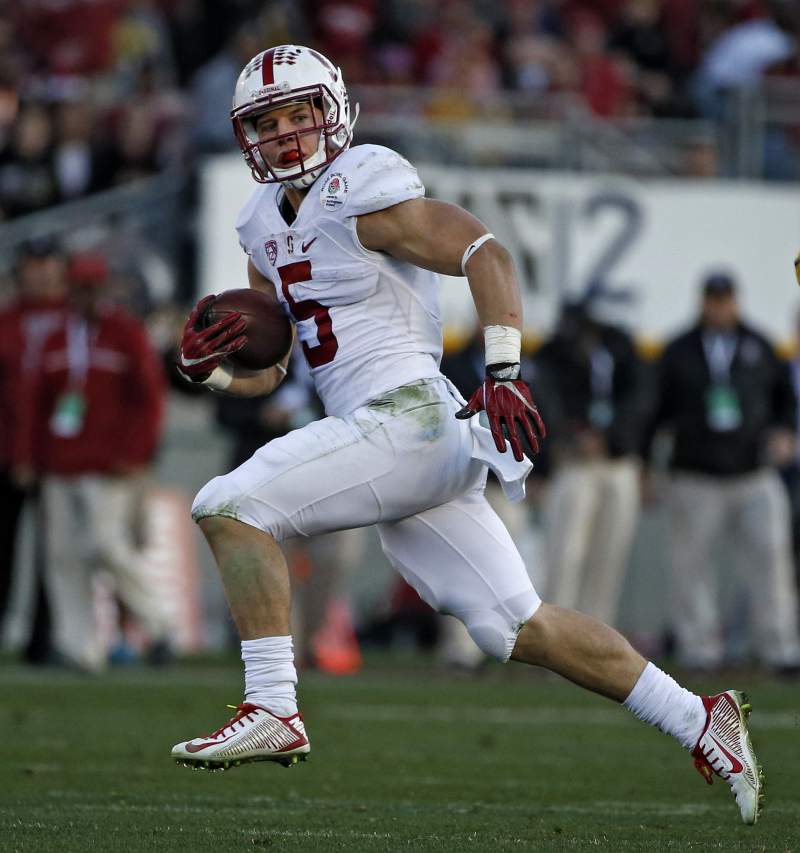Stanford Pin n Pull
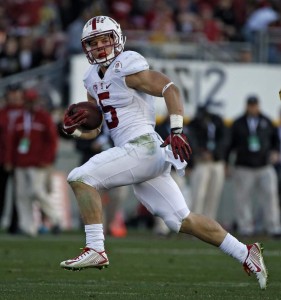
Stanford is one of the best in the country at utilizing the Pin and Pull Scheme (PNP). PNP is a style of outside zone that gives some offensive linemen better angles to achieve their blocks. Rather than rely on a full zone or reach scheme, PNP uses a combination of PIN or down blocks, and pulls.
TE:
The TE is they key to a successful PNP scheme. The TE will typically work to seal the edge by reaching a DE. If he is unable to hook the DE he will flip him outside and try to expand the C gap for the pullers and Rb to turn up inside.
Variations:
Against a C gap defender or 7 tech as many call it (often in an odd front) the TE can either pin him and rely on a puller to block whoever has walked up on the edge (D gap) or he can make a call for the OT and him to both reach playside.
There can be some variation in how the TE/PST choose to block this. A personnel or gameplanning decision will often dictate how they want to block the edge for the week. A team can also use blocking tags to tell the TE/PST when to follow the PIN or PULL rule, and when he and the OT should reach it.
Another variation is with the backside guard. Sometimes Stanford chooses to pull him playside as well, and use the backside tackle to cut any backside interior DT. My guess is they pull him when they think they can do it without risking a big loss and against the better DTs choose to zone it to avoid a big hole opening for a dominant DT to penetrate through and blow up the play int he backfield.
Pullers:
This scheme can use anywhere from 1 to 3 pullers from the OL working playside. They need to have vision like a good Rb as they aim to work around the block of the playside TE. A general coaching point would be to “follow his butt”. This means that as each OL pulls playside, he is looking to work off of the butt of the OL in front of him.
So as one OL pulls, if he sees TE’s butt getting around the edge, he follows it outside and works to either kick OUT a force player or lead UP. If he sees the TE’s butt facing him, the TE has had to kick out the DE, and he must turn up inside of this block. The next puller(s) are chasing/reading the butt of the puller in front of him. If he kicks out force, the butt will be facing them and they should turn up. If the butt gets square and is working around, they should follow it outside.
Stanford often ends up with a wall of bodies leading through the alley for Christian McCaffrey. It helps having a back with great vision as he can find holes that open up in the defense as they are stressed horizontally but teaching the OL to have great vision is critical to the play’s success.
I run a similar concept at my school and the general rule for all pullers in space is OUT, UP, IN. Their eyes/hips/feet should be following this general progression. First puller would likely be getting a kick out on force or leading up on a LB/SS. The next puller would be reading the butt and leading UP or IN based off of his block. I tell our pullers on this play they get to be a RB and find the holes.
Backside:
The backside OT and OG will scoop/reach their playside gaps while the general rule for the frontside OL is to PIN or PULL. Pin a defender if they have one to their inside gap, or pull playside to lead the play.
Below is a basic example of what PNP would look like against a 4 man front. The backside zones. The RT down blocks. The TE reaches the DE. The RG and C pull.
Diagram 1: Pin and Pull vs 4 man front
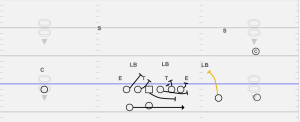
Here is an example against an odd front. Here the TE will pin the DE/7 tech and the OT will pull to the walked up OLB.
Diagram 2: Pin and Pull vs 5 man front
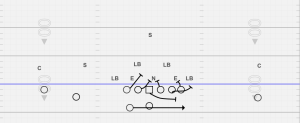
In this variation the TE and OT will work to reach the DE and OLB while the rest of the OL follows their PNP rules.
Diagram 3: Pin and Pull vs 5 man front with OT/TE REACH
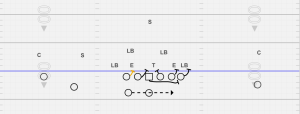
Below are video breakdowns of several of Stanford’s PNP runs from this season. These video breakdowns show some great examples of both the most basic PNP rule following scheme (first video), to their variations in the scheme (other videos).
Some more resources/info on the Pin n Pull Scheme can be found here, here, and here.
![]()

